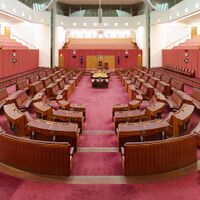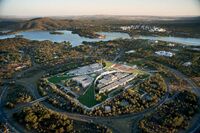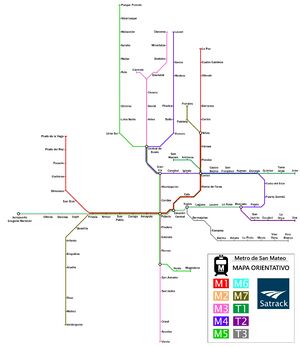Salerit
United States of Salerit | |
|---|---|
Coat of Arms
| |
| Motto: God will save us | |
| Anthem: "Triumph of Liberty" | |
| Capital | Reivel |
| Largest city | New Jesser |
| Official languages | none (the facto Salerian) |
| Recognised national languages | English, French, Spanish, German and Native. |
| Ethnic groups (2022) | White (62.6%) Black (12.4%) Asian (8%) Hispanoamerican (5%) Multiracial (10%) Native (1%) Other (1%) |
| Demonym(s) | Salerian |
| Government | Federal Presidential Republic |
• President of Saleria | Joe Kerley |
• Vice President | Katie Kei |
| Legislature | The Federal Congress |
| The Senate of the Republic | |
| The House of Representatives | |
| Area | |
• Total | 701,120 km2 (270,700 sq mi) |
| Population | |
• 2023 estimate | 97,912,699 |
• September 2022 census | 97,512,680 |
• Density | 139.65/km2 (361.7/sq mi) |
| GDP (PPP) | 2022 estimate |
• Total | 4,000,847,747,720 |
• Per capita | ACU 41 029 |
| GDP (nominal) | 2022 estimate |
• Total | ACU 3,370,720,809,560 |
• Per capita | ACU 34,567 |
| Gini (2022) | medium |
| HDI (2022) | very high |
| Currency | Salerian Dollar ($) 1 ACU = 1.05$ |
| Time zone | UTC -2, UTC -3 |
| Date format | dd-mm-yyyy |
| Driving side | right |
| Calling code | +76 |
| ISO 3166 code | SL |
| Internet TLD | .sl |
Salerit , officially the United States of Salerit is a country located in south-eastern Thuadia and northern Thrismari, including some islands. Salerit shares borders with Galicianna to the south, Vileria to the west and Gabrielland to the north. The 50 states and the Federal District that make up the country have a total area of xxxxx square km and a population of 97,912,699 according to the last census carried out in January 2023. Salerit is a presidential federal republic whose capital is Reivel, a city where all the country's institutions at the federal level. However, the most important cities economically and culturally are located on the coast; some being New Jesser, Caliry, San Pedro or Liago.
The territory of Salerit was originally inhabited by indigenous peoples, before colonizing peoples arrived from other places in Anteria at the end of the 15th century. Some of them established colonial territories on the central coast of the country, which became independent in the year 1780 from foreign powers in the Salerian Freedom War. In 1785, the Constitution was ratified; the only one that exists in the entire history of the country and that is still in force today with certain reforms. Little by little, new territories were annexed to the nation, until forming the current extension in the year 1876.
At the end of the 19th century and beginning of the 20th century, Salerit suffered a process of very rapid economic growth thanks to commercial, economic and and applied industrialization. Thus, the country went from being a poorly developed agricultural economy to one of the countries with the highest GDP in the region. All this was accompanied by strong population and export growth, which consolidated the country's economic system. Salerit remained neutral in all the international wars that occurred in the 20th century, thus consolidating its economic and political stability. In the 70s, Salerit suffered a severe crisis due to the creation of a real estate bubble that shook the economy and led to the closure of multiple companies. The country fixed this crisis by applying policies to contain public spending and investment in strategic economic sectors. At the beginning of the 21st century, multiple demonstrations and riots occurred in the country due to the lack of existence of a Welfare State like in other developed countries, and the little existing labor protection. After a few years of protests, successive governments approved measures such as universal healthcare, lowered university fees and approved aid for the most affected sectors of the population. These measures helped reduce inequality, but today the country remains one of the countries with the most wealth inequality in all of Anteria.
Salerit has a developed, high-income economy characterized by a high degree of economic freedom and low government intervention. It has a high GDP thanks to the relatively high population and a medium-high GDP per capita (which does not necessarily represent the average salary in the country due to high inequality). The country's main exports are planes, parts of planes, pharmaceutical products, electronic circuits, refined petroleum and cars.
Etymology
The name of the nation comes from the indigenous languages existing in the territory before colonization. "Sal" was the Aboriginal tribe that inhabited the first conquered territory, and "Erit" means "land of". Thus, as a whole, Salerit means "Land of the Sal"
Languages
The main language spoken throughout the territory is English (although it is not the de facto language throughout the country), which around 99% of the population knows how to speak. In the northwestern states of the country, the use of French stands out (spoken by around 75% of the population) due to the geographical and cultural proximity to Vileria. In the continental area located in Thrismari, Spanish is the majority language; being commonly spoken by around 87% of the population. In the southwest of the country there are some German-speaking minorities, representing around 14% of the total population of those states.
History
In process...
Geography
In process...
Government
The Republic of Salerit is a federation whose government is representative and elected by all citizens of the country, as indicated in the Constitution of 1785. The constitution establishes three levels of government: the federal government, the state governments and the counties. As established in the Constitution, all states must have representative government models that are elected through universal suffrage (which may be presidential, semi-presidential or parliamentary systems depending on the state). The separation of powers must be respected in these systems in all cases, regardless of the type of system chosen. Any form of government must be divided into three branches: the legislative power (elected through a system of universal suffrage and represented in one or two chambers), the executive (which may be elected directly or indirectly depending on the legislation of each state ) and the judicial (composed of a Supreme State Court and others of lower rank). Each state has its own Constitution or supreme laws and has a civil and judicial code.
The lowest-ranking administrative entities that have the power of self-government are counties. Each county is made up of several viscounties, entities without self-government. Every 4 or 5 years (depending on the state), each county elects its Local Representative. Each viscounty has one seat for representation on the County Council, and for every simple majority above 25% of the total votes that a political party obtains in a given viscounty, it will obtain a seat. Finally, a Local Representative vote is held in the County Council, and the representative with the most votes wins. In the event of a tie vote, the political party with the most total votes in the county will have the right to elect the Local Representative.
The legislative power at the federal level is bicameral, being formed by the House of Representatives and the Senate of the Republic. These two chambers are jointly responsible for approving laws and taxes at the federal level, declaring war on other nations, approving national budgets, and making international diplomatic pacts and treaties.
The House of Representatives is elected by universal suffrage, with each state having a mandatory representative and then the rest distributed proportionally to the population of each state. For a political party to obtain all the seats in a state, it must obtain at least 50.1% of the total votes. If this does not happen, the seats will be distributed proportionally among all political parties that have obtained more than 20% of the total votes in each state. The House of Representatives has a total of 500 seats in total.
The Senate of the Republic is elected by universal suffrage and proportionally at the federal level. This means that the senators are distributed depending on the percentage of the total votes they have obtained at the federal level. Parties must obtain more than 35% of the vote to be represented in the Senate, and they must have been the party with the most votes in at least one State. The Senate has a total of 100 senators.
The executive branch at the federal level is represented by the President of the Republic and his government cabinet. This is elected every 4 years by universal suffrage. To obtain the position of President, a candidate must be the most voted in at least 26 of the 50 states in total and obtain more than 50.1% of the total votes at the federal level. In order to run for President of the Republic, candidates must be part of one of the institutions of the legislative branch and be part of a political party with more than 20% representation in the House of Representatives. Once the President of the Government is elected, he appoints his government cabinet and forms the different departments and ministries.
The most important institutions of the judiciary throughout the country are the Supreme Court and the Constitutional Court.
The Supreme Court is made up of a total of 130 members, who are elected by vote among all the judges at the federal level of the Supreme State Courts. The one with the most votes is appointed President of the Supreme Court and the next four obtain vice presidencies. The other 125 members will be the most voted in list order (in case of a tie between two or more representatives, separate votes will be held). The Supreme Court is renewed every 6 years. This is the highest appeal body in the entire country, and always has the final say.
The Constitutional Court is made up of 25 members, and they are appointed by the President of the Government, having to obtain the acceptance of the House of Representatives, and, subsequently, of the Senate of the Republic. There is no maximum length of stay for judges, and for them to be replaced it is necessary to obtain an absolute majority of votes in the Senate. This court is in charge of interpreting the country's Constitution in certain cases where it is not very clear, and issues sentences accordingly.
All voting in all branches of power is supervised by the Federal Electoral Commission. Its members are elected by the judges of the Supreme Court by vote, and are responsible for avoiding any type of fraud and guaranteeing the correct counting of votes.
Since the founding of the country and the approval of the constitution in 1785 that establishes the current electoral system, the predominance of two political parties has stood out: the Conservative Party (with right-wing ideology) and the Liberal Party (with ideologies ranging from center-left to center-right). Both have alternated in power successively over the years depending on the electoral results. However, since the middle of the 20th century, the emergence of other parties such as the Progressive Party (extreme left), the Patriotic Union (extreme right) or some state-level parties stands out. The first two mentioned entered the House of Representatives in the 90s, breaking the traditional two-party system that existed in the country. Despite this, the Conservative Party and the Liberal Party continue to be the most important in the country and those that capture the majority of the votes.
At the state level, the diversity of political parties is much greater due to the existence of parliamentary systems in some states that favor multipartyism more. In certain states, political parties have governed through coalitions for many years, while in others two-partyism continues to predominate. All of this usually depends on the electoral legislation that each state has, the form of organization (parliamentary, presidential or semi-presidential) and the minimum percentages required of parties to be able to enter the bodies of legislative power.
| State | Population | Capital | Political party |
|---|---|---|---|
| SALFORN | 13 496 214 - 70 seats in House of Representatives | ||
| FEDERAL STATE | 10 267 276 - 39 seats in House of Representatives | ||
| NEW JESSER | 7 449 365 - 28 seats in House of Representatives | ||
| SAN MATEO | 4 468 130 - 26 seats in House of Representatives | ||
| MELOURN | 4 275 230 - 18 seats in House of Representatives | ||
| NEW PORTINGTON | 4 005 578 - 17 seats in House of Representatives | ||
| LAZEME | 3 936 327 - 15 seats in House of Representatives | ||
| SAN PEDRO | 3 648 114 - 13 seats in House of Representatives | ||
| SUCRY | 3 417 131 - 12 seats in House of Representatives | ||
| SANDALE | 3 139 821 - 11 seats in House of Representatives | ||
| GREEN BAY | 2 936 102 - 11 seats in House of Representatives | ||
| NEW LIORE | 2 678 947 - 10 seats in House of Representatives | ||
| GOLDLAND | 2 674 168 - 9 seats in House of Representatives | ||
| PIBLON | 2 379 174 - 8 seats in House of Representatives | ||
| NEW NASHTON | 2 344 197 - 8 seats in House of Representatives | ||
| HAMILTE | 2 277 308 - 8 seats in House of Representatives | ||
| CALIRY | 2 068 141 - 8 seats in House of Representatives | ||
| VILTIER | 2 045 820 - 7 seats in House of Representatives | ||
| PEITSEG | 1 998 957 - 7 seats in House of Representatives | ||
| CHEIRAS | 1 981 630 - 7 seats in House of Representatives | ||
| EAST LERO | 1 926 385 - 6 seats in House of Representatives | ||
| LEESERY | 1 758 347 - 6 seats in House of Representatives | ||
| ZERILA | 1 696 202 - 6 seats in House of Representatives | ||
| NAIHO | 1 578 870 - 6 seats in House of Representatives | ||
| WEST LERO | 1 529 438 - 5 seats in House of Representatives | ||
| VIRESIE | 1 498 166 - 5 seats in House of Representatives | ||
| REXAS | 1 338 223 - 4 seats in House of Representatives | ||
| YAREKA | 1 196 787 - 4 seats in House of Representatives | ||
| MALARADO | 1 131 329 - 4 seats in House of Representatives | ||
| NORTH VALAIS | 1 072 684 - 4 seats in House of Representatives | ||
| PAICAGO | 1 062 698 - 3 seats in House of Representatives | ||
| MEU | 1 019 312 - 3 seats in House of Representatives | ||
| SOUTH VALAIS | 994 307 - 3 seats in House of Representatives | ||
| PIRETY | 986 933 - 3 seats in House of Representatives | ||
| TANAVI | 715 903 - 3 seats in House of Representatives | ||
| NAIDORY | 658 042 - 2 seats in House of Representatives | ||
| PEKSEA | 499 822 - 2 seats in House of Representatives | ||
| SAINT NICOLAS | 474 464 - 2 seats in House of Representatives | ||
| WOHLSTAND | 386 223 - 2 seats in House of Representatives | ||
| LEXEN | 367 849 - 2 seats in House of Representatives | ||
| SOUTH TAMIWA | 362 899 - 2 seats in House of Representatives | ||
| NORTH TAMIWA | 291 805 - 2 seats in House of Representatives | ||
| WHENUA | 291 799 - 1 seats in House of Representatives | ||
| DC | 266 276 - 1 seats in House of Representatives | ||
| MEMADONA | 239 797 - 1 seats in House of Representatives | ||
| CAMBADA | 207 454 - 1 seats in House of Representatives | ||
| FRUCHTBAR | 195 301 - 1 seats in House of Representatives | ||
| NORTH SALHA | 167 129 - 1 seats in House of Representatives | ||
| SOUTH SALHA | 154 764 - 1 seats in House of Representatives |
Military
In process...
Economy
In process...
Demographics
Ethnic groups
Immigration
Major cities
Religion
Healthcare
Main article: Healthcare in Salerit
Education
Main article: Education in Salerit
Infraestructure and services
In process...
Culture
In process...
National Symbols
In process...





